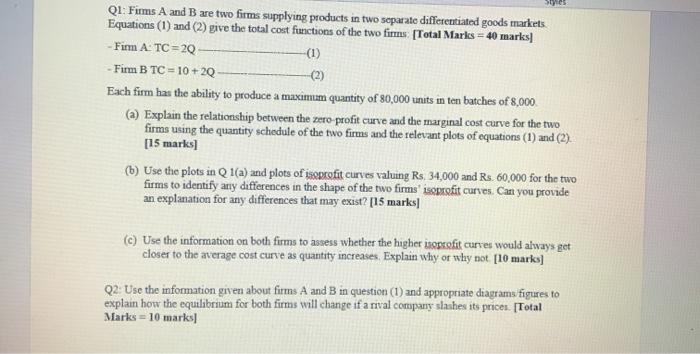Answered step by step
Verified Expert Solution
Question
1 Approved Answer
Q1: Firms A and B are two firms supplying products in two separate differentiated goods markets. Equations (1) and (2) give the total cost


Q1: Firms A and B are two firms supplying products in two separate differentiated goods markets. Equations (1) and (2) give the total cost functions of the two firms [Total Marks 40 marks] -Firm ATC=2Q -(1) -Firm B TC=10+2Q- -(2) Each firm has the ability to produce a maximum quantity of 80,000 units in ten batches of 8,000 (a) Explain the relationship between the zero-profit curve and the marginal cost curve for the two firms using the quantity schedule of the two firms and the relevant plots of equations (1) and (2) [15 marks] (b) Use the plots in Q 1(a) and plots of isoprofit curves valuing Rs. 34,000 and Rs. 60,000 for the two firms to identify any differences in the shape of the two firms' isoprofit curves. Can you provide an explanation for any differences that may exist? [15 marks] (c) Use the information on both firms to assess whether the higher isoprofit curves would always get closer to the average cost curve as quantity increases. Explain why or why not. [10 marks] Q2: Use the information given about firms A and B in question (1) and appropriate diagrams/figures to explain how the equilibrium for both firms will change if a rival company slashes its prices. [Total Marks = 10 marks] Q3: Use the information given about firm A in question (1) and appropriate diagrams/figures to explain how the equilibrium will change if it's cost of production rises to $5. [Total Marks = 10 marks]
Step by Step Solution
★★★★★
3.39 Rating (155 Votes )
There are 3 Steps involved in it
Step: 1

Get Instant Access to Expert-Tailored Solutions
See step-by-step solutions with expert insights and AI powered tools for academic success
Step: 2

Step: 3

Ace Your Homework with AI
Get the answers you need in no time with our AI-driven, step-by-step assistance
Get Started


